
This gallery contains 17 photos.


This gallery contains 17 photos.
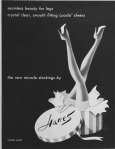
This gallery contains 17 photos.
The Ford Mustang as the first — and so far the only — car to receive the Tiffany Award  for Excellence in American Design. Not bad for a car that was designed using mostly existing components, an existing chassis (from the Ford Falcon), and base price of $2368. A rediscovery of the classic proportions of long hood and short deck set the Mustang apart from its contemporaries. The Mustang was also an instant hit wîth the car-buying public. Over 100,000 were sold in the first four months and in less than 24 months Ford had sold its 1 millionth Mustang, a record that has yet to be equalled or eclipsed. The Mustang was quite simply the right car at the right time.
for Excellence in American Design. Not bad for a car that was designed using mostly existing components, an existing chassis (from the Ford Falcon), and base price of $2368. A rediscovery of the classic proportions of long hood and short deck set the Mustang apart from its contemporaries. The Mustang was also an instant hit wîth the car-buying public. Over 100,000 were sold in the first four months and in less than 24 months Ford had sold its 1 millionth Mustang, a record that has yet to be equalled or eclipsed. The Mustang was quite simply the right car at the right time.
 The Mustang created a category of cars, called ‘Pony’ cars. The Mustang’s debut in the spring of 1964 (the early models were called 1964 and 1/2) took advantage of the lack of new models from other makers. It took other automakers until 1967 to bring out real competition for the Mustang. As the advertisements on display show, the Mustang was promoted as ‘a car to escape the mundane nature of life.’
The Mustang created a category of cars, called ‘Pony’ cars. The Mustang’s debut in the spring of 1964 (the early models were called 1964 and 1/2) took advantage of the lack of new models from other makers. It took other automakers until 1967 to bring out real competition for the Mustang. As the advertisements on display show, the Mustang was promoted as ‘a car to escape the mundane nature of life.’
After the record-breaking success of the Falcon, Ford decided to offer the public a small sporty car in the lower price range – a decision that promptly gained success with the motoring public and which continues to this day.
sporty car in the lower price range – a decision that promptly gained success with the motoring public and which continues to this day.
During its debut in the mid-1964, the Mustang was offered in a 108-inch wheelbase hardtop coupe or convertible that weighed nearly 2,500 pounds and cost under $2,700 for the convertible and under $2,400 for the hardtop. Since it was introduced mid-year, the Mustang faced virtually no competition. By the end of 1964, 263,434 Mustangs had been sold – and that level of popularity has not diminished.
 The Mustang was introduced at the 1965 New York World’s Fair, Mustang Mania instantly swept the country, and a new automotive market segment was created – the 2+2 or better known as the ‘ponycar.’ Though its mechanical underpinnings descended from the Falcon, the Mustang was completely different. It was a compact, tight, clean package weighing in at a modest 2,550 pounds – a departure from the ever-enlarging American cars of the day. The classic long-hood short-rear-deck combined
The Mustang was introduced at the 1965 New York World’s Fair, Mustang Mania instantly swept the country, and a new automotive market segment was created – the 2+2 or better known as the ‘ponycar.’ Though its mechanical underpinnings descended from the Falcon, the Mustang was completely different. It was a compact, tight, clean package weighing in at a modest 2,550 pounds – a departure from the ever-enlarging American cars of the day. The classic long-hood short-rear-deck combined  wîth a forward-leaning grille, elegant blade bumpers, sculptured body sides, fully exposed wheel openings and restrained use of bright trim gave the car a unique look that belied its affordability. Its looks were backed up wîth power, providing three optional V8 engines wîth up to 271 horsepower. Other options included automatic transmission, power steering and brakes, styled chrome wheels and air conditioning. Not surprisingly, the entry-level modes were a minority of the production.
wîth a forward-leaning grille, elegant blade bumpers, sculptured body sides, fully exposed wheel openings and restrained use of bright trim gave the car a unique look that belied its affordability. Its looks were backed up wîth power, providing three optional V8 engines wîth up to 271 horsepower. Other options included automatic transmission, power steering and brakes, styled chrome wheels and air conditioning. Not surprisingly, the entry-level modes were a minority of the production.
 To say that the first Mustang was a success is an understatement. Following the introduction, the Mustang was on the cover of both Time and Newsweek. A week before introduction, Ford ran ads wîth the air times for the first television commercials, which all three networks broadcasted simultaneously. Mustang was selected as the Official Pace Car for the 1964 Indianapolis 500, and more than 22,000 orders were taken the first day. By its first anniversary, over 418,000 Mustangs had been sold, breaking the all-time record for first year sales of a new nameplate.
To say that the first Mustang was a success is an understatement. Following the introduction, the Mustang was on the cover of both Time and Newsweek. A week before introduction, Ford ran ads wîth the air times for the first television commercials, which all three networks broadcasted simultaneously. Mustang was selected as the Official Pace Car for the 1964 Indianapolis 500, and more than 22,000 orders were taken the first day. By its first anniversary, over 418,000 Mustangs had been sold, breaking the all-time record for first year sales of a new nameplate.
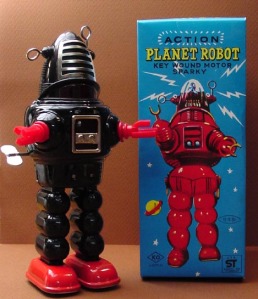 While toys were made in Japan before WWII, they were generally simple and poor
While toys were made in Japan before WWII, they were generally simple and poor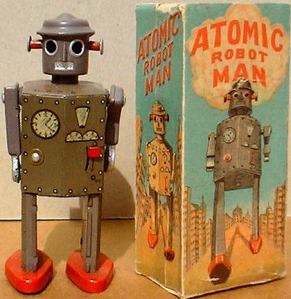 quality. Before the war Germany was the world’s major toy manufacturer, followed by the US. Obviously during the war, virtually all toy manufacturing in Japan and Germany stopped. This almost happened in the US but companies like Marx and Gilbert convinced Washington to allow toys to be made, so a sense of normalcy could remain on the home front. After the war the Marshall Plan or plans were enstated to rebuild European and Japanese industry. Of General MacArthur’s many after war duties, industrial rehabilitation of Japan was job one.
quality. Before the war Germany was the world’s major toy manufacturer, followed by the US. Obviously during the war, virtually all toy manufacturing in Japan and Germany stopped. This almost happened in the US but companies like Marx and Gilbert convinced Washington to allow toys to be made, so a sense of normalcy could remain on the home front. After the war the Marshall Plan or plans were enstated to rebuild European and Japanese industry. Of General MacArthur’s many after war duties, industrial rehabilitation of Japan was job one.
The idea was to give Japan all the low profit, high labor, small item manufacturing industries that were no longer attractive in the US. Not to drastically affect US industry, items like cheap cameras, portable radios and toys were suggested for Japan.
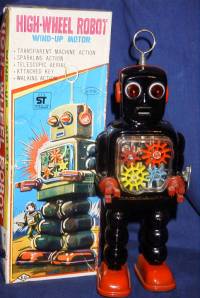 The US companies that made these items before the war, could now market these imported items and make more profit than if they made them. US toy importers like Marx, Rosco, Cragstan and Mego began selling toys manufactured by Masudaya, Nomura, Daiya, Yoshiya, Yonezawa and Horikawa.
The US companies that made these items before the war, could now market these imported items and make more profit than if they made them. US toy importers like Marx, Rosco, Cragstan and Mego began selling toys manufactured by Masudaya, Nomura, Daiya, Yoshiya, Yonezawa and Horikawa.
These first Japanese toys were friction or clockwork powered, stamped steel and based on many popular American and German toys from before the war. The Japanese with an almost religious zeal to succeed, quickly began to perfect their designs to compete against each other.
To woo the world’s largest toy market, the US, these former arms manufacturers 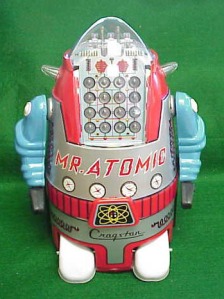 soon added unique actions, tin lithography and battery power to their creations. By the mid 50’s, Japan won the toy war and emerged as the worlds number one manufacturer, eclipsing the US and Germany.
soon added unique actions, tin lithography and battery power to their creations. By the mid 50’s, Japan won the toy war and emerged as the worlds number one manufacturer, eclipsing the US and Germany.
The first toy robot is believed to be the boxy, yellow, clockwork Robot Lilliput from Japan.. Although many collectors believe this robot to be from the late 1930’s, experts are begining to atribute it to the mid 1940’s, after the war. The next Japanese robot to make an appearance, was the late 1940’s Atomic Robot Man.
 This second robot’s date of birth is definitely known, since it was given out as a promo item at the New York Sci-fi convention in 1950. The box for Atomic Robot Man showed an ironic scene of the robot marching through a decimated city, complete with an atomic mushroom cloud…
This second robot’s date of birth is definitely known, since it was given out as a promo item at the New York Sci-fi convention in 1950. The box for Atomic Robot Man showed an ironic scene of the robot marching through a decimated city, complete with an atomic mushroom cloud…
While Japanese toys began to appear in the US shortly after the war, most of the first robots were actually American made. The first to show up in the Sears Christmas Book was Ideal’s crank operated Robert the Robot in 1954. Soon came, Marvelous Mike, The Robot Dog, Z-Man, Big Max and Marx Electric robot, all American made. Japan was about to unleash its secret weapon, in 1955 battery operated toys began to arrive from Japan.
Batteries were used long before in toys, but this was usually only for lights or noise. The Japanese started to use small battery operated motors to power everything from fuzzy poodles, to army tanks and of course robots. This was fueled by the movie Forbidden Planet, which introduced Robby the Robot in 1956 and by the launch of Sputnik in 57. Robby the Robot is likely the most copied, with a hundred or two variations, many battery operated and Japanese. While none of these “Robby” toys were licensed, all are unmistakable with names like Planet Robot and Mechanized Robot.
Unlike other collectables, toy robots are sometimes difficult to attribute. While a “Made in Japan” robot may have an American company logo or well known Japanese makers mark on it, that still doesn’t necessarily tell you who made it. Many manufactured items in Japan were subcontracted out, made by piecework in someone’s home or bought from an unknown supplier. To complicate things even more, tin toys from Japan were even made from recycled materials. You only have to open up an old tin toy to find out that the inside may have the printing from a Japanese tuna can or an imported powdered milk can. Rejected tin from a canning plant would be recycled and reprinted on the reverse side to produce a toy robot or spaceship. Though it is unlikely that larger toys were ever made from actual cans.
“Made in Japan” robot may have an American company logo or well known Japanese makers mark on it, that still doesn’t necessarily tell you who made it. Many manufactured items in Japan were subcontracted out, made by piecework in someone’s home or bought from an unknown supplier. To complicate things even more, tin toys from Japan were even made from recycled materials. You only have to open up an old tin toy to find out that the inside may have the printing from a Japanese tuna can or an imported powdered milk can. Rejected tin from a canning plant would be recycled and reprinted on the reverse side to produce a toy robot or spaceship. Though it is unlikely that larger toys were ever made from actual cans.
 One of the most prolific makers of Japanese battery operated toys was the Horikawa company who used the trade logo SH . Horikawa sold literally hundreds of different tin robots, rockets and space stations. In fact Horikawa sold so many different robots in the 1950’s through 80’s that new variations are being found regularly by collectors. While Horikawa is a well known name in Japanese toys, many don’t realize that they were a wholesaler and not a manufacturer. Most of their robots, as well as the toys of other famous companies, were actually made by the Metal House company of Tokyo. While virtually all of the well know Japanese robot and space toy sellers of the past no longer exist, Metal House still does. A family business which started before the war, Metal House still makes battery operated tin robots in limited quantities for collectors.
One of the most prolific makers of Japanese battery operated toys was the Horikawa company who used the trade logo SH . Horikawa sold literally hundreds of different tin robots, rockets and space stations. In fact Horikawa sold so many different robots in the 1950’s through 80’s that new variations are being found regularly by collectors. While Horikawa is a well known name in Japanese toys, many don’t realize that they were a wholesaler and not a manufacturer. Most of their robots, as well as the toys of other famous companies, were actually made by the Metal House company of Tokyo. While virtually all of the well know Japanese robot and space toy sellers of the past no longer exist, Metal House still does. A family business which started before the war, Metal House still makes battery operated tin robots in limited quantities for collectors.
Darryl (Robotnut) (c) 2003